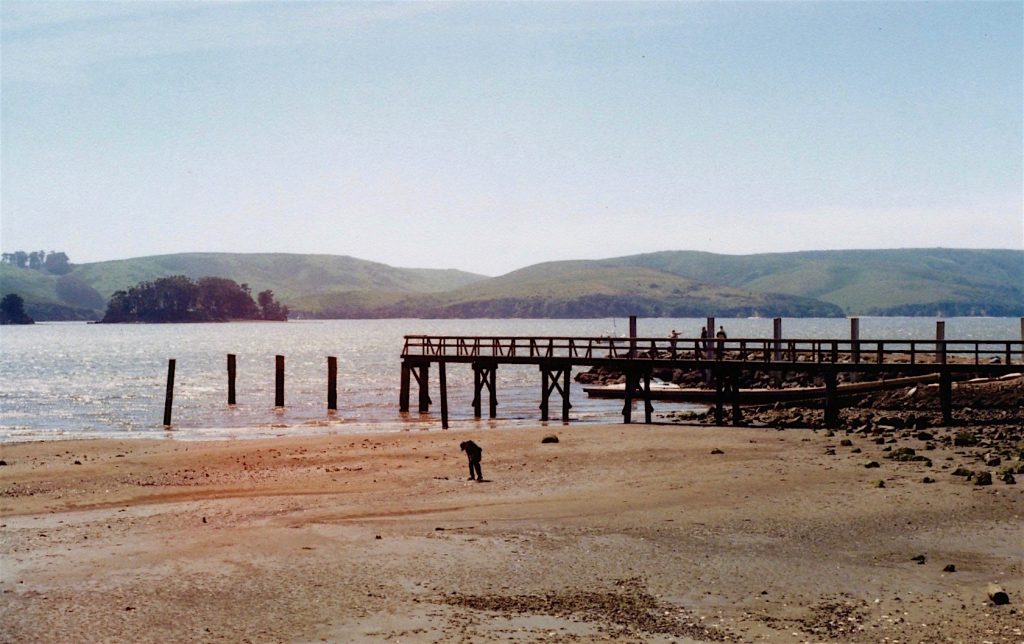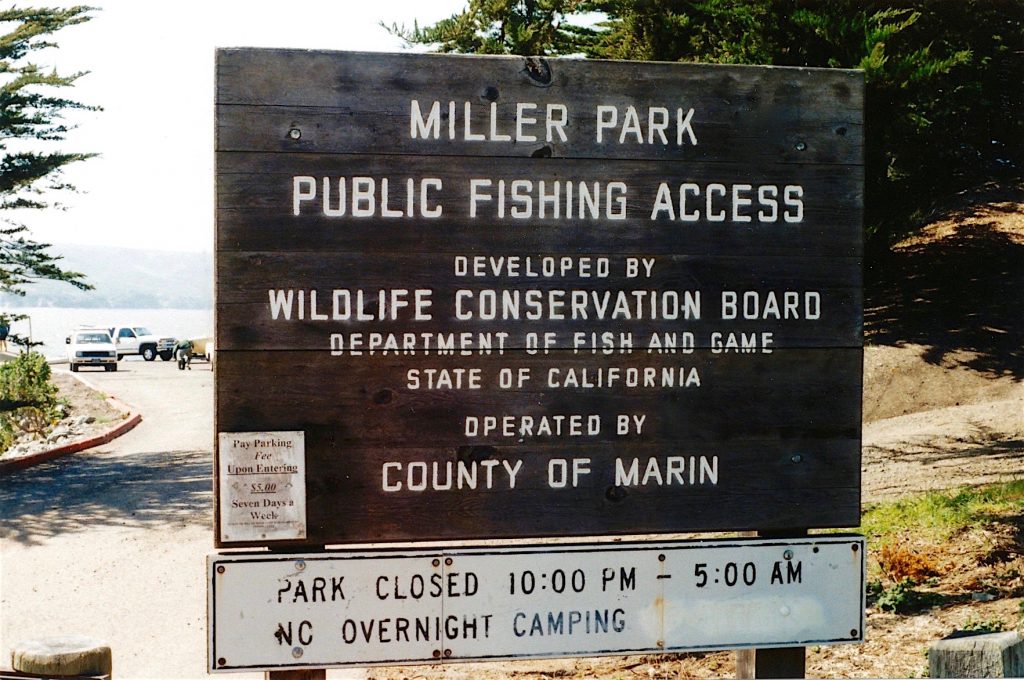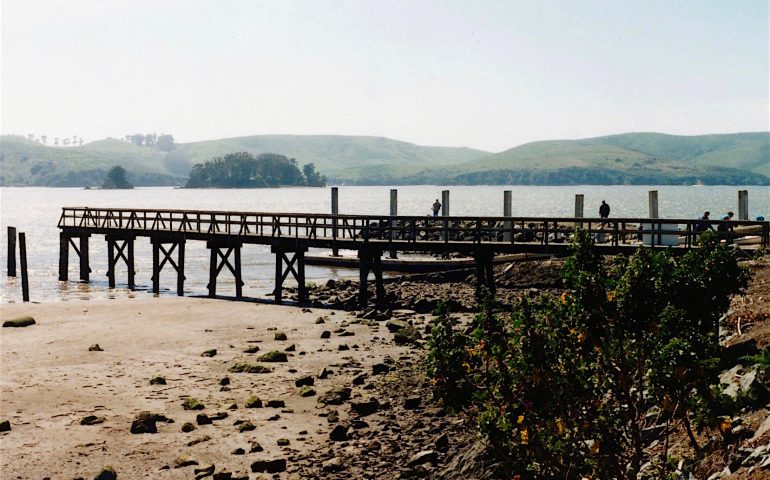On November 29, 1954 the Wildlife Conservation Board, part of the California Department of Fish and Game, allocated $5,500 for the development of Miller Park at Nick’s Cove on Tomales Bay, a park designed for fishing access. That fund was inadequate and basically nothing happened until April 30, 1958, when the board allocated an additional $33,100. The money was to cover the cost of a paved parking area, launch ramps, boat floats, and a rock jetty to protect the ramps. Construction began but would not be completed until 1959 (after an additional expenditure of $8,137 to meet the low bid).
In addition, in January 1965 an additional $3,300 was budgeted for repairs to fix winter storm damage from the devastating floods of 1964-65.
At that time of its opening in 1959 there was a boat launch, the small jetty, and an adjacent small pier that was called the Miller Park Pier.
The pier was short; measuring only 130 feet long and 4 feet wide, with much of its length sitting over the shore itself. As a consequence, most anglers huddled near the end trying to cast to deeper water. And, due to its size, angling space could be limited. Nevertheless, it was used by local anglers until destroyed in the late 1980s.
The launch site itself remains one of the favorite sites for launching boats and kayaks in Tomales Bay. In addition, many anglers continue to use the shoreline and rock jetty in the park for fishing. However, pier anglers had no place to fish until 2007 when a new pier was built across the cove at Nick’s Cove Restaurant and Cottages.

Fishing: Given its length, the pier was basically a shallow-water pier that limited to some degree the fish that could be caught. However, being adjacent to the boat launch and rock jetty helped the fishing as well as the pier having wooden pilings (that fish like). In addition eelgrass beds sit out from the pier, vegetation that is attractive to some fish, especially blackperch.
What were the fish? A variety of perch species were common but particularly common were blackperch, shinerperch and dwarf perch. Less consistent but a possibility were walleye surfperch, silver surfperch, barred surfperch, calico surfperch and a few striped seaperch.
Jacksmelt and topsmelt were a common catch while occasionally the smaller “true” smelt, surf smelt and eulachon, might also make an appearance.
Bottom species included flatfish—sand sole, speckled sanddab, diamond turbot and starry flounder (whose numbers have gone down over the years). Small halibut were occasionally caught but most of the bigger “hallies” were caught in deeper water.
Perhaps the best fishing was reserved for the sharays—sharks and rays. The site was good for leopard sharks and brown smoothhounds while bat rays, some in excess of a hundred pounds, provided the “biggest” and most exciting catch. Less common sharks were angel sharks, dogfish sharks, and soupfin sharks. Skates could also show, especially big skates.
And then there were the crabs, both Dungeness and rock crabs, both of which could be abundant at different times of the year.
In summary, the fishing was generally fairly slow with the exception of sharks and rays. Nevertheless, anglers continued to flock to the pier when it was open. You just never knew when a striped bass might be traveling along the shoreline, or a halibut might wander in from the deeper waters.

How To get There: Miller Boat Launch and Nick’s Cove can be found three miles north of the small town of Marshall on the Highway 1 in Marin County.

What’s up people—so my sister’s boyfriend wouldn’t shut up about a site he kept playing on during their last trip to New Zealand. Out of boredom, I gave it a go and ended up spending a few too many nights on All Slots Casino. Not mad though—the range of slots is wild, and the interface doesn’t look like something from the dial-up era. Haven’t had issues with payments, and it doesn’t freeze up mid-game, which is more than I can say for half the stuff out there.
Hello, everyone! I’m a student, and I usually spend my free time reading or watching TV series, but yesterday I tried Spinmama, and it turned out to be unexpectedly fun. Spinning the reels is exciting, and the graphics are bright and unobtrusive. Even if you don’t win, you still smile because the process itself is enjoyable. Sometimes I play a couple of spins before a date, and it immediately lifts my mood. I highly recommend it to anyone who wants light and relaxing entertainment.
The OVO game is one of the best browser reflex games.
rr88 Nền tảng giải trí trực tuyến cao cấp được xây dựng trên nền tảng công nghệ tiên tiến hàng đầu, tích hợp hệ sinh thái nội dung phong phú, đa dạng và được tuyển chọn khắt khe. Hệ thống vận hành ổn định, mượt mà, đáp ứng các tiêu chuẩn bảo mật nghiêm ngặt, đảm bảo an toàn thông tin tối đa cho người dùng. Không chỉ dừng lại ở việc đáp ứng nhu cầu giải trí, nền tảng còn tập trung kiến tạo trải nghiệm đồng bộ, bền vững và khác biệt, mang đến giá trị lâu dài cùng sự hài lòng vượt trên mọi kỳ vọng.
vvjl is a trusted entertainment brand from the Philippines, known for its stable system, clear operations, and modern design. The platform provides a wide range of games, secure payment methods, and attentive customer service, creating a safe and enjoyable experience for users.
luckywin Nền tảng giải trí trực tuyến cao cấp được phát triển trên nền tảng công nghệ tiên tiến hàng đầu, tích hợp hệ sinh thái nội dung phong phú, đa dạng và được tuyển chọn nghiêm ngặt. Hệ thống vận hành ổn định, mượt mà, tuân thủ các tiêu chuẩn bảo mật khắt khe, đảm bảo an toàn thông tin tối đa cho người dùng. Không chỉ đơn thuần đáp ứng nhu cầu giải trí, nền tảng còn hướng tới việc kiến tạo trải nghiệm đồng bộ, bền vững và khác biệt, mang lại giá trị lâu dài cùng sự hài lòng vượt trên mọi kỳ vọng.
bảo an toàn thông tin tối đa cho người dùng.
j88.com được nhiều người lựa chọn nhờ hệ thống trò chơi phong phú, hình ảnh rõ nét và cách vận hành trơn tru. Nền tảng này chú trọng bảo mật thông tin, nạp rút thuận tiện, đồng thời hỗ trợ khách hàng nhanh, tạo cảm giác an tâm khi trải nghiệm.
là nền tảng giải trí trực tuyến nổi bật với giao diện hiện đại và tốc độ xử lý mượt mà. Hệ thống cung cấp nhiều lựa chọn trò chơi phong phú, tỷ lệ thưởng hấp dẫn và cơ chế trả thưởng minh bạch. Với đội ngũ chăm sóc khách hàng chuyên nghiệp và chính sách bảo mật cao, mang đến trải nghiệm an toàn và tiện lợi cho người chơi.
rr88 – là một nền tảng giải trí trực tuyến hoạt động hợp pháp ở nhiều thị trường, tập trung vào trải nghiệm người dùng và tính minh bạch. Thương hiệu này cung cấp hệ sinh thái dịch vụ đa dạng, giao diện thân thiện, tốc độ xử lý ổn định và hệ thống bảo mật được chú trọng.
Nhà Cái XX88 – Nền tảng giải trí trực tuyến cao cấp, ứng dụng công nghệ tiên tiến và sở hữu hệ sinh thái nội dung phong phú, được tuyển chọn kỹ lưỡng. Hệ thống vận hành ổn định, bảo mật tối ưu, mang đến trải nghiệm mượt mà, khác biệt và giá trị bền vững cho người dùng.
[…] Link 671: 789P Link 672: 789P Link 673: 789P Link 674: 789P Link 675: 789P Link 676: 789P Link 677: 789P Link 678: 789P Link 679: 789P Link 680: 789P Link 681: 789P Link 682: 789P Link 683: 789P Link 684: […]